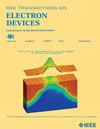具有阻壁聚束机制的行波管及电场同步相互作用的研究
IF 2.9
2区 工程技术
Q2 ENGINEERING, ELECTRICAL & ELECTRONIC
引用次数: 0
摘要
在电阻壁放大器(RWAs)中,电路波与电子束之间不存在相互作用,电子束的进一步聚集是由电子束与电阻壁表面等离子体驱动的空间电荷场相互作用引起的。然而,由于电阻壁结构不能激发空间电荷波,需要一个耦合系统来预调制电子束。因此,对于相同的增益,rwa的管长相对较长。本文旨在将行波管的聚束机制与传统行波管的相互作用机制相结合,使行波管中既有空间电荷场对聚束的辅助作用,又有电路场与电子束的同步相互作用。计算结果表明,这种新型集成机构不仅缩短了管长,而且提高了增益。本文章由计算机程序翻译,如有差异,请以英文原文为准。
Studies on Traveling Wave Tubes With the Bunching Mechanism of Resistive Wall and the Circuit-Field Synchronous Interaction
There is no interaction between the circuit wave and the electron beam in resistive wall amplifiers (RWAs), and the further bunching of the electron beam is caused by the interaction between the electron beam and the space charge field driven by the surface plasmons in the resistive wall. However, due to the inability of the resistive wall structure to excite space charge waves, a coupling system is necessary to pre-modulate the electron beam. Consequently, the tube length of RWAs is relatively longer for the same gain. This article aims to integrate the bunching mechanism of RWAs with the interaction mechanism of traditional traveling wave tubes (TWTs), so that there is both an aiding effect of the space charge field on bunching and a synchronous interaction between the circuit-field and the electron beam in a TWT. The calculation results suggest that this new integrated mechanism not only reduces the tube length but also improves the gain.
求助全文
通过发布文献求助,成功后即可免费获取论文全文。
去求助
来源期刊

IEEE Transactions on Electron Devices
工程技术-工程:电子与电气
CiteScore
5.80
自引率
16.10%
发文量
937
审稿时长
3.8 months
期刊介绍:
IEEE Transactions on Electron Devices publishes original and significant contributions relating to the theory, modeling, design, performance and reliability of electron and ion integrated circuit devices and interconnects, involving insulators, metals, organic materials, micro-plasmas, semiconductors, quantum-effect structures, vacuum devices, and emerging materials with applications in bioelectronics, biomedical electronics, computation, communications, displays, microelectromechanics, imaging, micro-actuators, nanoelectronics, optoelectronics, photovoltaics, power ICs and micro-sensors. Tutorial and review papers on these subjects are also published and occasional special issues appear to present a collection of papers which treat particular areas in more depth and breadth.
 求助内容:
求助内容: 应助结果提醒方式:
应助结果提醒方式:


